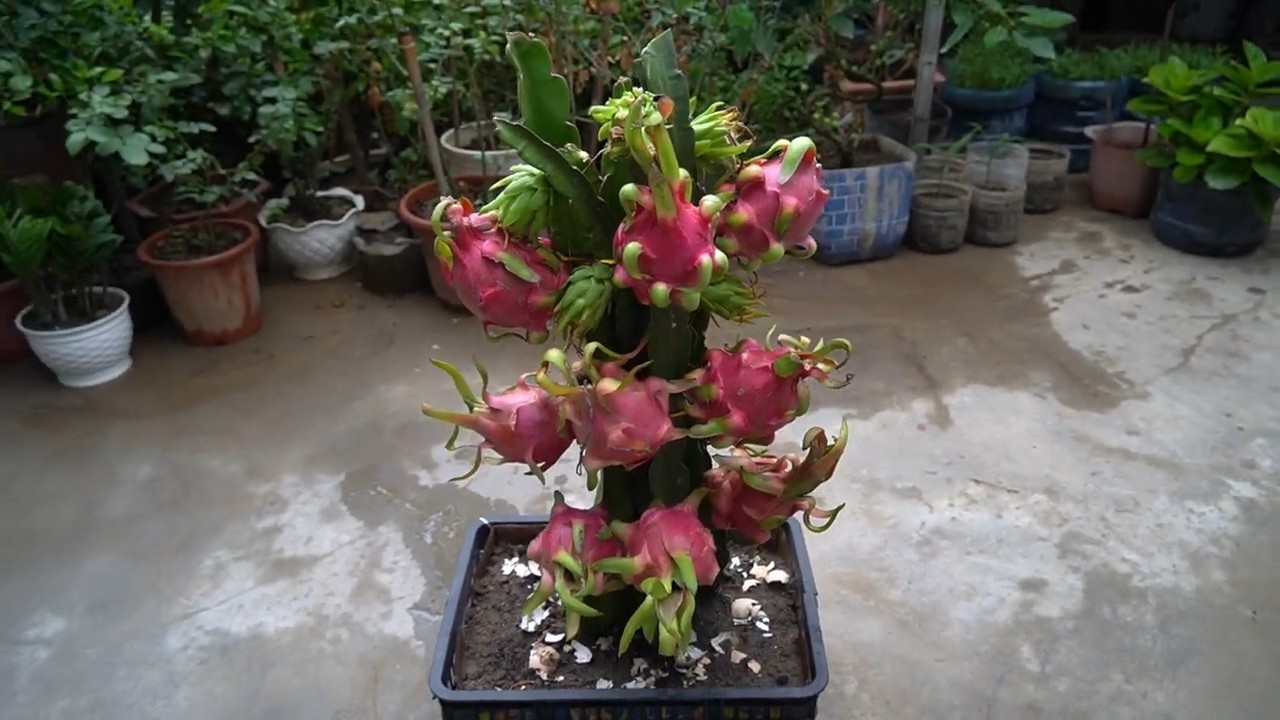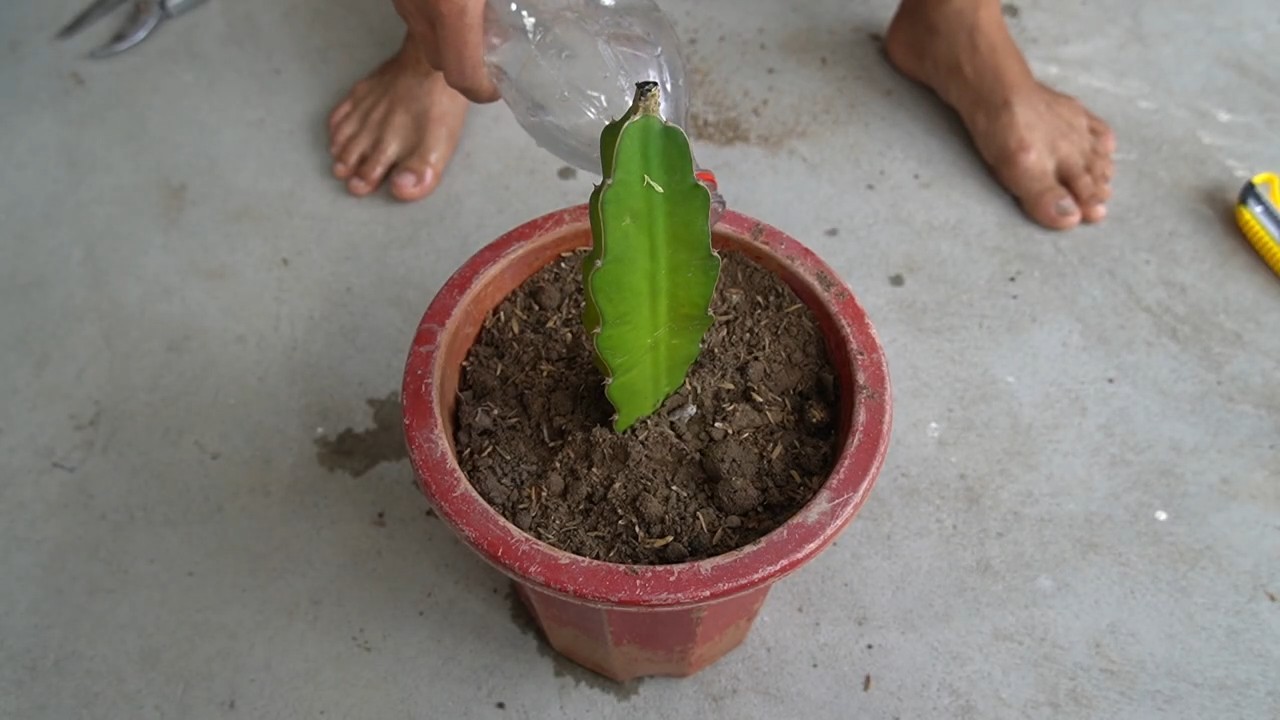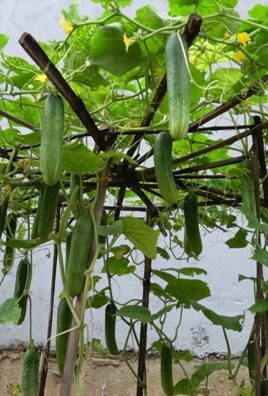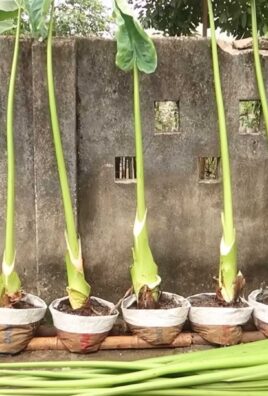Dragon Fruit Propagation Cuttings: Ever dreamed of having your own exotic dragon fruit vine bursting with vibrant, otherworldly fruit? I know I have! And guess what? It’s way easier than you think, especially when you learn the magic of propagation through cuttings. Forget expensive nursery plants; we’re diving into the world of DIY dragon fruit growing!
For centuries, dragon fruit, also known as pitaya, has been cherished in Southeast Asia and Latin America, not just for its delicious taste but also for its stunning beauty. Imagine bringing that tropical flair right to your own backyard! But beyond the aesthetic appeal, growing your own dragon fruit is incredibly rewarding. You get to control the growing process, ensuring organic practices and ultimately enjoying the freshest, most flavorful fruit imaginable.
Why should you learn this particular DIY trick? Well, dragon fruit plants can be a bit pricey to buy fully grown. Plus, starting from cuttings is a fantastic way to multiply your plants from a single, healthy specimen. It’s cost-effective, sustainable, and incredibly satisfying to watch your little cutting transform into a thriving, fruit-bearing vine. So, if you’re ready to unlock the secrets of dragon fruit propagation cuttings and embark on a rewarding gardening adventure, let’s get started! I’m excited to share my tried-and-true methods with you.

Propagating Dragon Fruit from Cuttings: A Step-by-Step Guide
Hey there, fellow plant enthusiasts! Ever wanted to grow your own exotic dragon fruit? It’s easier than you might think, and propagating from cuttings is a fantastic way to get started. I’ve had great success with this method, and I’m excited to share my knowledge with you so you can enjoy the fruits (literally!) of your labor.
What You’ll Need
Before we dive in, let’s gather our supplies. Having everything ready beforehand will make the process smooth and enjoyable.
* A Healthy Dragon Fruit Plant: This is your source for cuttings. Look for a mature plant with healthy, vibrant green stems.
* Sharp, Clean Pruning Shears or Knife: Sterilize your cutting tools with rubbing alcohol to prevent the spread of diseases.
* Rooting Hormone (Optional but Recommended): This will encourage faster and more robust root development. I personally prefer using a powdered rooting hormone.
* Well-Draining Potting Mix: A mix designed for cacti and succulents works perfectly. You can also create your own by combining equal parts potting soil, perlite, and coarse sand.
* Pots or Containers: Choose pots that are at least 6 inches in diameter to give the cuttings enough room to grow. Make sure they have drainage holes!
* Watering Can or Spray Bottle: For gentle watering.
* Gloves (Optional): Dragon fruit stems can have small spines, so gloves can protect your hands.
* Stakes or Support (Optional): Depending on the size of your cuttings, you might need stakes to support them as they grow.
* Rubbing Alcohol: For sterilizing your tools.
Choosing and Preparing Your Cuttings
This is a crucial step! Selecting the right cuttings will significantly impact your success rate.
* Select Healthy Stems: Look for stems that are mature, healthy, and free from any signs of disease or damage. Avoid stems that are too young or too old.
* Cutting Length: Aim for cuttings that are between 6 and 12 inches long. Longer cuttings will have more energy reserves to support root development.
* Cutting Angle: Make a clean, angled cut at the bottom of the stem. This will increase the surface area for root formation.
* Callousing: Allow the cut ends of the cuttings to callous over for 3-7 days. This helps prevent rot and encourages root growth. Place the cuttings in a dry, shaded area during this time. I usually stand them upright in an empty pot.
Planting Your Dragon Fruit Cuttings
Now for the fun part – getting those cuttings into the soil!
1. Prepare Your Pots: Fill your pots with the well-draining potting mix, leaving about an inch of space at the top.
2. Apply Rooting Hormone (Optional): If using rooting hormone, dip the calloused end of the cutting into the powder, tapping off any excess.
3. Plant the Cutting: Insert the calloused end of the cutting into the potting mix, burying it about 2-3 inches deep. Make sure the cutting is upright and stable.
4. Water Gently: Water the potting mix gently until it is evenly moist but not waterlogged. Avoid overwatering, as this can lead to rot.
5. Provide Support (Optional): If your cuttings are tall or unstable, insert a stake into the pot and tie the cutting to the stake for support.
Caring for Your Dragon Fruit Cuttings
Proper care is essential for successful rooting and growth.
1. Location: Place the potted cuttings in a warm, bright location with indirect sunlight. Avoid direct sunlight, which can scorch the cuttings. A spot near an east-facing window is ideal.
2. Watering: Water the cuttings sparingly, allowing the potting mix to dry out slightly between waterings. Overwatering is a common mistake that can lead to rot. I usually check the soil moisture by sticking my finger about an inch deep. If it feels dry, it’s time to water.
3. Humidity: Dragon fruit plants thrive in humid environments. You can increase humidity by misting the cuttings regularly or placing the pots on a tray filled with pebbles and water. Make sure the bottom of the pot isn’t sitting directly in the water.
4. Temperature: Maintain a temperature between 65°F and 80°F (18°C and 27°C).
5. Fertilizing: Once the cuttings have developed roots (usually after 4-8 weeks), you can start fertilizing them with a balanced liquid fertilizer diluted to half strength. Fertilize every 2-4 weeks during the growing season (spring and summer).
6. Patience: Rooting can take several weeks, so be patient and don’t disturb the cuttings too much. You’ll know the cuttings have rooted when you see new growth emerging from the top.
Transplanting Your Dragon Fruit Seedlings
Once your cuttings have developed a strong root system and are showing healthy growth, it’s time to transplant them into larger pots or into the ground (if you live in a suitable climate).
1. Choose a Suitable Location: Dragon fruit plants need plenty of sunlight (at least 6 hours per day) and well-draining soil. If you’re planting in the ground, choose a location that is protected from strong winds.
2. Prepare the Soil: Amend the soil with compost or other organic matter to improve drainage and fertility.
3. Dig a Hole: Dig a hole that is slightly larger than the root ball of the seedling.
4. Carefully Remove the Seedling: Gently remove the seedling from its pot, being careful not to damage the roots.
5. Plant the Seedling: Place the seedling in the hole and backfill with soil, gently firming it around the base of the plant.
6. Water Thoroughly: Water the newly transplanted seedling thoroughly.
7. Provide Support: Dragon fruit plants are climbing cacti, so they need a strong support structure to grow on. You can use a trellis, a fence, or a sturdy post.
8. Mulch: Apply a layer of mulch around the base of the plant to help retain moisture and suppress weeds.
Troubleshooting
Even with the best care, you might encounter some challenges. Here are a few common problems and how to address them:
* Rotting Cuttings: This is usually caused by overwatering or poor drainage. Make sure your potting mix is well-draining and avoid overwatering. If a cutting starts to rot, remove it immediately to prevent the spread of disease.
* Lack of Rooting: This can be caused by several factors, including insufficient humidity, low temperatures, or poor-quality cuttings. Try increasing humidity by misting the cuttings regularly or placing them in a humidity dome. Make sure the temperature is within the optimal range (65°F to 80°F). If you’re still having trouble, try using a stronger rooting hormone.
* Yellowing Leaves: This can be caused by overwatering, underwatering, or nutrient deficiencies. Check the soil moisture and adjust your watering accordingly. If the leaves are yellowing due to nutrient deficiencies, fertilize the cuttings with a balanced liquid fertilizer.
* Pests: Dragon fruit plants can be susceptible to pests such as mealybugs and scale. Inspect your plants regularly for signs of pests and treat them with an appropriate insecticide if necessary. I prefer using neem oil as a natural and effective solution.
Additional Tips for Success
* Take Multiple Cuttings: Propagating from cuttings isn’t always 100% successful, so it’s a good idea to take multiple cuttings to increase your chances of success.
* Label Your Cuttings: If you’re propagating different varieties of dragon fruit, be sure to label your cuttings so you can keep track of them.
* Be Patient: Rooting can take several weeks, so be patient and don’t give up!
* Join a Gardening Community: Connect with other gardeners online or in your local area to share tips and advice.
Understanding Dragon Fruit Growth Habits
Dragon fruit, also known as pitaya or pitahaya, is a fascinating climbing cactus. Understanding its growth habits is key to providing the right support and care.
* Aerial Roots: Dragon fruit plants produce aerial roots that help them cling to supports. These roots are not parasitic; they simply provide stability.
* Climbing Nature: As mentioned earlier, dragon fruit plants are climbers. They need a strong support structure to grow on, such as a trellis, a fence, or a sturdy post. Without support, they will sprawl along the ground.
* Flowering and Fruiting: Dragon fruit plants typically start flowering and fruiting after 1-2 years of growth. The flowers are large, fragrant, and bloom at night. The fruits are typically ready to harvest about 30

Conclusion
So, there you have it! Mastering dragon fruit propagation from cuttings is not just a fun gardening project; it’s a gateway to a bountiful harvest of this exotic and delicious fruit, right in your own backyard. Forget expensive nursery plants – this DIY method empowers you to create multiple dragon fruit vines from a single, healthy cutting, saving you money and giving you the satisfaction of nurturing new life.
Why is this a must-try? Because it’s incredibly rewarding, surprisingly simple, and significantly more cost-effective than purchasing mature plants. Imagine the joy of watching your tiny cutting sprout roots and transform into a thriving vine, laden with vibrant pink fruit. Plus, you’ll have complete control over the variety you grow, ensuring you get the exact flavor and characteristics you desire.
But the benefits don’t stop there. Propagating from cuttings allows you to easily share your passion with friends and family. Imagine gifting them a dragon fruit cutting, knowing you’re giving them the opportunity to experience the same joy and satisfaction you’ve found. It’s a gift that keeps on giving!
Looking for variations? Experiment with different rooting mediums. While well-draining soil mix is a reliable choice, you can also try perlite, vermiculite, or even just water. Each medium offers slightly different benefits, so find what works best for your environment and growing style. You can also try rooting hormone to speed up the process, although it’s not strictly necessary. Another variation is to experiment with different sizes of cuttings. While the recommended size is around 6-12 inches, you can try smaller or larger cuttings to see how they perform. Just remember to adjust your watering and care accordingly.
Don’t be afraid to experiment and adapt the process to your specific needs and preferences. The key is to provide your cuttings with the right conditions: warmth, humidity, and well-draining soil.
We’ve covered the essentials of dragon fruit propagation from cuttings, but the real magic happens when you put these techniques into practice. So, grab your pruning shears, select a healthy dragon fruit stem, and embark on this exciting gardening adventure. You’ll be amazed at how easy and rewarding it is to create your own dragon fruit paradise.
We’re confident that with a little patience and care, you’ll be enjoying your own homegrown dragon fruit in no time. And remember, the journey is just as important as the destination. Embrace the learning process, celebrate your successes, and don’t be discouraged by occasional setbacks. Gardening is all about experimentation and growth, both for your plants and for yourself.
Now, it’s your turn! We encourage you to try this DIY trick and share your experience with us. Post photos of your cuttings, share your tips and tricks, and let us know what worked best for you. Together, we can create a community of dragon fruit enthusiasts, sharing our knowledge and passion for this amazing fruit. Let us know if you have any questions, and we’ll do our best to help you along the way. Happy growing!
Frequently Asked Questions (FAQ)
What is the best time of year to propagate dragon fruit cuttings?
The ideal time for dragon fruit propagation from cuttings is during the warmer months, typically spring or early summer. This is when the plant is actively growing, and the cuttings will root more quickly and easily. However, if you live in a climate with consistently warm temperatures, you can propagate dragon fruit cuttings year-round. Just be sure to provide adequate warmth and humidity, especially during the cooler months. Avoid propagating during periods of extreme heat or cold, as this can stress the cuttings and reduce their chances of success.
How long does it take for dragon fruit cuttings to root?
The rooting time for dragon fruit cuttings can vary depending on several factors, including the variety of dragon fruit, the temperature, humidity, and the rooting medium used. Generally, you can expect to see roots forming within 2-4 weeks. However, it may take longer in cooler conditions or if the cutting is not receiving enough moisture. Be patient and avoid disturbing the cutting too often, as this can hinder the rooting process. Once the roots are well-established, you can transplant the cutting into a larger pot or directly into the ground.
What kind of soil is best for rooting dragon fruit cuttings?
Dragon fruit cuttings thrive in well-draining soil. A mix of potting soil, perlite, and coarse sand is ideal. This combination provides good drainage, aeration, and moisture retention. Avoid using heavy clay soils, as they can become waterlogged and lead to root rot. You can also use a cactus or succulent potting mix, as these are specifically formulated for plants that prefer well-draining soil. Ensure the pot you use has drainage holes to prevent water from accumulating at the bottom.
How often should I water dragon fruit cuttings?
Water dragon fruit cuttings regularly, but avoid overwatering. The soil should be kept consistently moist, but not soggy. Water when the top inch of soil feels dry to the touch. During the warmer months, you may need to water more frequently. In cooler months, reduce watering to prevent root rot. Always check the soil moisture before watering to ensure the cutting is not sitting in standing water. Good drainage is essential to prevent overwatering.
Do dragon fruit cuttings need sunlight?
Yes, dragon fruit cuttings need sunlight, but they should be protected from direct, intense sunlight, especially during the hottest part of the day. Place the cuttings in a location that receives bright, indirect sunlight. A partially shaded area or a spot near a window with filtered light is ideal. Too much direct sunlight can scorch the leaves and damage the cutting. As the cutting grows and develops roots, you can gradually acclimate it to more sunlight.
Can I use rooting hormone on dragon fruit cuttings?
Yes, you can use rooting hormone on dragon fruit cuttings to speed up the rooting process. Rooting hormone contains auxins, which are plant hormones that promote root development. Dip the cut end of the cutting in rooting hormone powder or liquid before planting it in the rooting medium. While rooting hormone is not essential, it can increase the success rate of propagation, especially for cuttings that are difficult to root. Follow the instructions on the rooting hormone product for best results.
How do I know if my dragon fruit cutting has rooted?
You can tell if your dragon fruit cutting has rooted by gently tugging on it. If the cutting resists being pulled out of the soil, it has likely developed roots. You can also check for new growth, such as new leaves or shoots, which is a sign that the cutting is actively growing and has established roots. Avoid pulling the cutting out of the soil completely to check for roots, as this can damage the delicate root system.
What do I do after my dragon fruit cutting has rooted?
Once your dragon fruit cutting has rooted, you can transplant it into a larger pot or directly into the ground. Choose a location that receives plenty of sunlight and has well-draining soil. Water the newly transplanted cutting regularly and fertilize it with a balanced fertilizer to promote healthy growth. Provide support for the vine to climb, such as a trellis or fence. With proper care, your dragon fruit cutting will grow into a mature vine and produce delicious fruit.
What are some common problems when propagating dragon fruit cuttings and how can I fix them?
Some common problems when propagating dragon fruit cuttings include root rot, fungal infections, and pest infestations. Root rot is caused by overwatering and poor drainage. To prevent root rot, use well-draining soil and avoid overwatering. Fungal infections can occur in humid conditions. To prevent fungal infections, provide good air circulation and avoid wetting the leaves when watering. Pest infestations can be controlled with insecticidal soap or neem oil. Regularly inspect your cuttings for signs of pests or diseases and take action promptly to prevent them from spreading.
Can I propagate dragon fruit cuttings in water?
Yes, you can propagate dragon fruit cuttings in water. Place the cut end of the cutting in a jar or glass of water, ensuring that the leaves are not submerged. Change the water every few days to prevent the growth of bacteria. Once the roots are about an inch long, you can transplant the cutting into a pot with well-draining soil. Water propagation can be a good option for those who want to monitor the root development of their cuttings. However, cuttings propagated in water may need to be gradually acclimated to soil to prevent transplant shock.




Leave a Comment